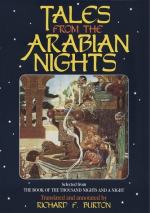[FN#320] This quatrain occurs in Night ix.: I have borrowed from Torrens (p. 79) by way of variety.
[FN#321] The belief that young pigeon’s blood resembles the virginal discharge is universal; but the blood most resembling man’s is that of the pig which in other points is so very human. In our day Arabs and Hindus rarely submit to inspection the nuptial sheet as practiced by the Israelites and Persians. The bride takes to bed a white kerchief with which she staunches the blood and next morning the stains are displayed in the Harem. In Darfour this is done by the bridegroom. “Prima Venus debet esse cruenta,” say the Easterns with much truth, and they have no faith in our complaisant creed which allows the hymen-membrane to disappear by any but one accident.
[FN#322] Not meaning the two central divisions commanded by the King and his Wazir.
[FN#323] Ironice.
[FN#324] Arab. “Rasy"=praising in a funeral sermon.
[FN#325] Arab. “Manaya,” plur. of “Maniyat” = death. Mr. R. S. Poole (the Academy, April 26, 1879) reproaches Mr. Payne for confounding “Muniyat” (desire) with “Maniyat” (death) but both are written the same except when vowel-points are used.
[FN#326] Arab. “Iddat,” alluding to the months of celibacy which, according to Moslem law, must be passed by a divorced woman before she can re-marry.
[FN#327] Arab. “Talak bi’l-Salasah"=a triple divorce which cannot be revoked; nor can the divorcer re-marry the same woman till after consummation with another husband. This subject will continually recur.
[FN#328] An allusion to a custom of the pagan Arabs in the days of ignorant Heathenism The blood or brain, soul or personality of the murdered man formed a bird called Sady or Hamah (not the Huma or Humai, usually translated “phoenix”) which sprang from the head, where four of the five senses have their seat, and haunted his tomb, crying continually, “Uskuni!"=Give me drink (of the slayer’s blood) ! and which disappeared only when the vendetta was accomplished. Mohammed forbade the belief. Amongst the Southern Slavs the cuckoo is supposed to be the sister of a murdered man ever calling or vengeance.
[FN#329] To obtain a blessing and show how he valued it.
[FN#330] Well-known tribes of proto-historic Arabs who flourished before the time of Abraham: see Koran (chaps. xxvi. et passim). They will be repeatedly mentioned in The Nights and notes.
[FN#331] Arab. “Amtar”; plur. of “Matr,” a large vessel of leather or wood for water, etc.
[FN#332] Arab. “Asafiri,” so called because they attract sparrows (asafir) a bird very fond of the ripe oily fruit. In the Romance of “Antar” Asafir camels are beasts that fly like birds in fleetness. The reader must not confound the olives of the text with the hard unripe berries ("little plums pickled in stale”) which appear at English tables, nor wonder that bread and olives are the beef-steak and potatoes of many Mediterranean peoples It is an excellent diet, the highly oleaginous fruit supplying the necessary carbon,




